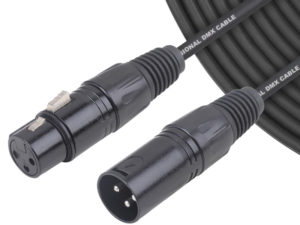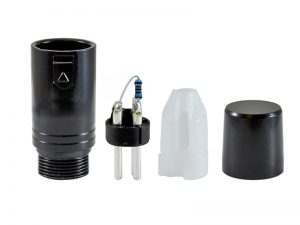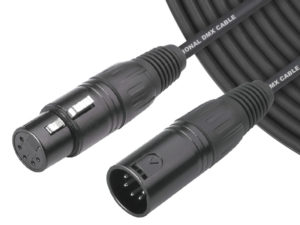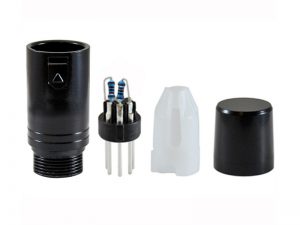What is the DMX512 lighting control cable (AES/EBU Digital audio Cable)?
What is the DMX512 lighting control cable (AES/EBU Digital audio Cable)?
DMX cable signal is based on RS485 signal, a kind of industry-standard protocol after adjusting the transmit Baud rate. Usually there are one pair DMX512 lighting control cable and two pair DMX512 lighting control cable.
Cable types that are appropriate for DMX512 usage will have a nominal characteristic impedance of 110(±22)ohms,at frequencies from 0.1MHz to 128 times the maximum frame rate when measured at the output terminals. The signal amplitude shall lie between 2V and 7V peak-to-peak when measured across a 110 ohm resistor connected to the output terminals, without any interconnecting cable present.NOTE a typical value is 4V±10%. At the short distances, cables with higher capacitance and different characteristic impedance such as microphone cable can be used. However, the significantly lower impedance and higher capacitance of these cables distort the DMX512 digital waveforms, which in turn can cause irregular operation or intermittent errors that are difficult to identify and correct. Cat5 cable, commonly used for networking and telecommunications, has been tested by ESTA for use with DMX512A. Also, cables designed for EIA485 typically meet the DMX512 electrical specifications.
| Twist pair digital audio cable technical specifications | |||||
| No. | Item | Unit | Type I | Type II | |
| 1 | Conductor O.D | mm | 0.61 | ||
| 2 | Conductor section | mm2 | 0.23mm (24AWG) | ||
| 3 | Characteristic impedance | Ω | 110±22 | ||
| 4 | Attenuation | 2MHz | dB/100m | ≤4.3 | ≤4.5 |
| 4MHz | ≤5.2 | ≤5.5 | |||
| 5MHz | ≤5.6 | ≤6.0 | |||
| 6MHz | ≤6.0 | ≤6.5 | |||
| 12MHz | ≤7.5 | ≤8.3 | |||
| 25MHz | ≤10.1 | ≤11.4 | |||
| 5 | Insulation resistance (20°C) | MΩ.Km | ≧5000 | ||
| 6 | Capacity (C/C) @ 1kHz | pF/m | ≤85 | ||
AES/EBU were developed by the Audio Engineering Society (AES) and the European Broadcasting Union (EBU) and first published in 1985, later revised in 1992 and 2003. The digital audio standard frequently called AES/EBU, officially known as AES3 (Digital Audio Interface), is used for carrying digital audio signals between various devices.Both AES and EBU versions of the standard exist. Several different physical connectors are also defined as part of the overall group of standards.
AES / EBU Digital Audio Cable is a developed multi-purpose product based on 110 ohm with common characteristic of impedance, available applying to AES / EBU audio (AES3) with DMX-512 signal. For the market providing a digital wire, which is flexible, easy to be used on mobile performance. To get this goal, we adopt double shielding the aluminum foil layer and braided shielding. Such as our DL11 and DL12, they are applying to AES/EBU audio with DMX-512 signal, based on 110ohm. It can accurately transmit AES/EBU audio 100M by point to point.


The IEC 60958 series is based on two different industry standards: the AES/EBU digital audio interface standard(AES3 and EBU Tech.3250-E) and the digital interface specification by Sony and Phillips(Sony-Philips Digital interface format(SPDIF)) introduced with the compact Disc Digital Audio system.
Originally, the DMX-512 standard was created specifying 5-pin XLR style cables. This entailed a DMX positive, DMX negative, and ground or common, along with two additional this pins for potential future adoption. At the time of this article’s writing, no such adoption has ever occurred, and over time, cost among other reasons, has driven many manufacturers to opt for 3-pin XLR cables or even the lower-cost, smaller still, RJ45 ethernet-style jack.

DMX cable is created to carry the much higher bandwidth (and frequency) digital signal of DMX and has much higher impedance. With DMX, there are tons of packets of data traveling through the cable carrying crucial lighting data that a microphone cable might not be able to effectively relay. So what is the proper cable? According to the DMX specification, the cable must be 110 ohm to meet the standard.
The DMX out on the controller is linked via a DMX512 cable to the DMX in on the first fixture. A second cable then links the DMX out on the first fixture to the next device, and so on – up to 32 devices. In general, the final, empty, DMX out connector should have a DMX512 terminating plug attached into it, which is simply a 110ohm resistor joining pins 2 and 3 of the connector.such as our DMX Terminator, 3-pin XLR 110R DMX terminator (DMX3M001), 5-pin XLR 110R DMX terminator(DMX5M001).





评论
发表评论